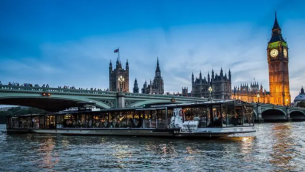There has been a dramatic increase in the number of natural disasters over the past few years, and it is assumed that global warming and climate change could cause even more disasters in the future. Some of the world’s leading cities are facing disasters like floods and heat waves.
London
London’s flood defences are getting older. Since 1982, the Thames Barrier(水闸)has protected the city from the threat of flooding, but it was only designed to last until 2030 and close once every two or three years. About 26 years later, the barrier now closes five or six times a year and according to Environment Agency predictions, by 2050 the barrier will be closed on almost every tide if the problem is not addressed.
There are 26 underground stations, 400 schools, 16 hospitals, an airport and 80 billion worth of property in London’s flood risk area, so large scale flooding would be disastrous.
Paris
Over a sixweek period in July and August 2003, more than 11, 400—mainly elderly people—died in France from dehydration(脱水)and extremely high body temperature in a deadly heat wave. Heat waves of similar intensity(强度)are expected every seven years by 2050, so what can be done to make sure such a disaster does not happen again?
One solution is to have airconditioners installed in elderly care homes. But this is considered a shortterm solution, as the increase in demand for electricity also increases carbon emissions(排放).
In Paris the local authorities are encouraging architects to design new types of buildings such as the building “Flower Tower”, which uses a covering of bamboo to act as a natural airconditioner.
Shanghai
Shanghai is one of the fastest growing cities on Earth. It has a population of 18 million and is only 4 meters above sea level. Sea levels are predicted to rise by 20 cm within the next century.
An estimated 250,000 people move to Shanghai every year in search of work, placing extra demands on energy consumption. China relies heavily on coalfired power stations, but these emissions increase temperatures and, in turn, warmer seas increase the risk of typhoons.
1. What problem should be settled now in London?| A.How to protect the city’s property. |
| B.Where to build its flood defences. |
| C.How to use the Thames Barrier to protect the city. |
| D.How to improve the function of the old flood defences. |
| A.Putting up new types of buildings with a covering of bamboo. |
| B.Having airconditioners installed in elderly care homes. |
| C.Forbidding the city to build “Flower Tower”. |
| D.Encouraging architects to design new types of buildings. |
| A.to tell us how to protect the big cities |
| B.to give advice on how to defend natural disasters |
| C.to explain what causes flood and heat waves |
| D.to warn us of the increasing natural disasters in big cities |
| A.Big Cities Facing Big Disasters |
| B.Big Disasters in the Future |
| C.The Increase of Natural Disasters |
| D.Solutions to Natural Disasters |
相似题推荐
【推荐1】An earthquake happens when two plates rub together. The earth plates travel in different directions and at a different speed. If one plate is slowly forced underneath the other,pressure(压力)builds up until the plates break apart. This process(过程)causes the ground to move. It is an earth-quake. In other words,earthquakes are the shaking of the earth’s surface caused by the earth’s rocky outer layer as a result of the energy stored within the earth. The strain within the rocks is suddenly released(释放).
The damage an earthquake causes depends on where it is and when it is happening. If an unpopulated region is struck, there will be low loss of life or property(财产). If it hits a large city,there may be many injuries and much destruction. Many of the areas at risk are largely populated now. Major earthquakes hitting those areas today could produce terrible damage.
Actually, there are several million small earthquakes every year. Large earthquakes, such as the 1964 Alaska earthquake that measured 9.2 on the Richter scale, caused millions of dollars in damage. In the last 500 years, millions of people have been killed by earthquakes around the world-including over 240,000 in the 1976 Tangshan earthquake in China.
A60-second or less earthquake can cause devastation that continues for years after the first tremor. In 1972, a series of severe earthquakes struck Managua, Nicaragua. Fifteen years later, the city still looked the way it had a week after the earthquake hit, because the country did not have the necessary money to rebuild it.
The shaking of the earth is sometimes not the greatest disaster. It is in the ensuing fires and floods that often the greatest damage occurs. In the 1906 earthquake, it was the fires caused after it that did the majority of the damage. An earthquake can also destroy dams high above a city or valleys, causing floods to sweep down and sweep away everything in their path.
1. Which of the following is the main idea of the first paragraph?| A.An earthquake comes from the inside of the earth. |
| B.The earth has great energy in storage. |
| C.How the earth plates move. |
| D.How an earthquake happens. |
| A.Causing too much heat and great damage. |
| B.Causing many injuries and much destruction. |
| C.Happening as a result of another event. |
| D.Happening suddenly and unexpectedly. |
| A.an earthquake doesn’t last long | B.the damage can last long |
| C.people in Managua suffered too much | D.Nicaragua is still a poor country |
【推荐2】Wildfire, or wildland fire, is the uncontrolled fire occurring in a forest, grassland or bushlands.
Fire danger in a wildland setting varies with weather conditions: drought, heat, and wind. Once a fire is burning, drought, heat, and wind all increase its intensity. Topography(地形) also affects wildfire, which spreads quickly uphill and slowly downhill. Dried grass, leaves, and light branches are considered flash fuels, and fire spreads quickly in them, often generating enough heat to burn heavier fuels such as tree stumps(树桩), heavy branches, and the organic matter of the forest floor. Such fuels, ordinarily slow to burn, are difficult to extinguish. Green fuels—growing vegetation-are not considered to catch fire easily, but an intense fire can dry out leaves and needles quickly enough to allow ready burning. Green fuels sometimes carry a special danger. Evergreens, such as pine and spruce(云杉), contain oils that easily burst into flames when heated sufficiently by the searing drafts(灼热的气流) of a forest fire.
Firefighting forces are specially trained to deal with wildfires. Aircraft were first used in fighting wildland fires in 1919. Now airplanes and helicopters are primarily used for dumping water, for observation, and occasionally for assisting in communication and transporting personnel, supplies, and equipment
Tools for fighting wildfires range from the standard equipment of urban fire departments to portable pumps, tank trucks, and earth-moving equipment. It can also change the fire’s direction as well as slowing its progress. They are maintained by public and private owners of forestlands. Such a force may attack a fire directly by spraying water, beating out flames, and removing vegetation at the edge of the fire to contain it behind a fire line. When the very edge is too hot to approach, a fire line is built at a safe distance, sometimes using strip (长条地带) burning to get rid of the fuel in the path of the uncontrolled fire.
1. What is Paragraph 2 mainly about?| A.What causes wildfire to happen. |
| B.How topography affects wildfire intensity. |
| C.Why wildfire danger hides in green fuels. |
| D.Where wildfire often breaks out. |
| A.Carrying thin leaves. A. When the fire dies down. |
| B.Having heavy branches. |
| C.Lacking enough water. |
| D.Containing some oil. |
| A.When the fire dies down. |
| B.When the wind blows hard. |
| C.When the fuel burns uncontrollably. |
| D.When the pump works effectively. |
| A.An advertisement brochure. |
| B.A news report. |
| C.A sci-fi lecture, |
| D.A geography magazine. |
【推荐3】Torrential rains have hit China In July, with 617.1mm of water reportedly falling form Saturday to Tuesday in Zhengzhou, for which more than 100,000 people have been evacuated. The scenes of devastation(破坏)in Zhengzhou added to a list of disasters this year that have raised the fear of climate change.
As the effects of climate change become more disastrous, well-known research institutions and government agencies are focusing new money and attention on an idea: artificially cooling the planet, in the hopes of buying humanity more time to cut greenhouse gas emissions.
That strategy, called solar geoengineering, involves reflecting more of the sun's energy back into space to abruptly reduce global temperatures. The idea has been considered as a dangerous and fancied solution, one that would encourage people to keep burning fossil fuels while on the other hand exposing the planet to unexpected threatening side effects, producing more destructive hurricanes, wildfires, floods and other disasters.
But as global warming continues, producing more destructive hurricanes, wildfires, floods and other disasters. some experts say that concerns about geoengineering should be outweighed by the imperative to better understand it, in case the consequence of climate change become so terrible that the world can't wait for better solutions.
One way to cool the earth is by injecting aerosols(气溶胶)into the upper layer of the atmosphere, where those particles(粒子)reflect sunlight away from the earth. That process works, according to MacMartin, a researcher at Cornell University.
“We know with 100% certainty that we can cool the planet,” he said. What's still unclear, he added, is what happens next. Temperature, MacMartin said, is an indicator for a lot of climate effects. “What does it do to the strength of hurricanes?” he asked, “What does it do to agriculture production? What does it do to the risk of forest fires?”
Another institution funded by the National Science Foundation will analyze simulations of aerosol injection, testing the effects on Weather extremes around the world. One goal of the research is to look for a sweet spot: the amount of artificial cooling that can reduce extreme weather events without causing broader changes in regional rainfall patterns or similar impacts.
1. What is the major function of the first paragraph?| A.To offer basic knowledge of the topic. | B.To summarize the main idea of the passage. |
| C.To lead to the theme of the whole passage. | D.To show Zhengzhou suffered heavy losses in the rainstorm. |
| A.To prevent natural disasters. | B.To win more time to reduce greenhouse gas emissions. |
| C.To imitate volcanic eruptions. | D.To encourage more people to burn fossil fuels. |
| A.More volcanoes will throw out. | B.More solar energy will go into space. |
| C.More disasters will endanger the future of the world. | D.People will keep burning fossil fuels to keep warm. |
| A.He thinks more research remains to be done. |
| B.He is optimistic about the effect of cooling the earth. |
| C.He is concerned about the reduction in agriculture production. |
| D.He disapproves of the practice of solar geoengineering. |
 | In Factfulness, Professor Hans Roslingasks raises questions like ‘How many girls finish school?’ and ‘What percentage of the world’s population is poor?’ It turns out that the majority of us get the answers to these questions completely wrong. Why does this happen? Factfulness sets out to explain why, showing that there are several human instincts that distort(扭曲)our perspective. This book focuses on our instinctive biases(偏见), offering practical advice to help us see the good as well as the bad in the world. |
 | Are things getting worse every day? Is progress an impossible goal? In Enlightenment Now, Steven Pinker looks at the big picture of human progress and finds good news. We are living longer, healthier, freer and happier lives. Pinker asks us to stop paying so much attention to negative headlines and news that declares the end of the world. Instead, he shows us some carefully selected data. In 75 surprising graphs, we see that safety, peace, knowledge and health are getting better all over the world. Economic inequality, he claims, is not really a problem, because it is not actually that important for human well-being. |
 | For more than two hundred years those who hold negative thoughts have been winning the public debate. They tell us that things are getting worse. But as a matter of fact, life is getting better. Income, food availability and lifespan are rising; disease, violence and child mortality are falling. Best-selling author Matt Ridley doesn’t only explain how things are getting better; he gives us reasons why as well. He shows us how human culture evolves in a positive direction thanks to the exchange of ideas and specialization. This bold book looks at the entirety of human history-from the Stone Age to the 21st century—and changes the concept that it’s all going downhill. |
 | The majority of people believe that developing countries are in a terrible situation: suffering from incredible poverty and wars. The reality is that a great transformation is occurring. Over the past 20 years, more than 700 million people have increased their income and come out of poverty. This is happening across developing countries around the world. In his book The Great Surge, Stevens Radelet describes how all of this is happening and, more importantly, it shows us how we can speed up the process. |
| A.They focus on the present situations concerning developing countries. |
| B.They emphasize the importance of dealing with problems in poor countries. |
| C.They try to direct readers to a positive path in terms of human development. |
| D.They appeal to show more sympathy and understanding for poor countries. |
| A.Hans Roslingasks. | B.Steven Pinker. | C.Matt Ridley. | D.Stevens Radelet. |
| A.The Rational Optimist. | B.Human History: Where Are We? |
| C.A Public Debate. | D.Out of Povetty: What and How? |
【推荐2】Read the directions of the medicine before you take it.
Tablespoonful 汤匙 teaspoonful茶匙 dose 剂量
| Adults 2 tablespoonfuls Children :according to age 10-14 years 4 teaspoonfuls 6-10 years 2 teaspoonfuls 3-6 years 1 teaspoonful Repeat above dose every 1/2 hour to 1 if needed until 8 doses are taken. If you do not get better, see a doctor please. |
1. Where can you usually see it ?
| A.On the wall in front of the shop. | B.In the newspaper. |
| C.On the bottles of medicine. | D.In the streets near the hospital. |
| A.Add some hot water to it. |
| B.Read the instructions carefully. |
| C.Move the bottle quickly up and down. |
| D.Go and ask the doctor’s advice. |
| A.A grow-up. | B.A 10-to-14-year-old child. |
| C.A 3-to-6-year-old-child. | D.A 6-to-10-year-old child. |
| A.See a doctor | B.Change it for some better medicine. |
| C.Stop taking it. | D.Take more doses. |
【推荐3】Travel around England

Places to visit in London
☆ The Thames
It runs through London, dividing the city into two parts. It’s interesting to take a trip on the river. This way, you can see almost every place of interest of London.
☆ Big Ben
May 31, 2019 is the 160th birthday of the largest four-face clock in the world—Big Ben. It isn’t the name of the tower itself but the 13-ton bell inside it. Every hour, it “bongs” the number of hours to tell the time.
Places to visit in Liverpool
☆Music: “The Beatles Story”
If you love the Beatles—the world-famous 1960s music group, come here!
Open every day except Dec 25 and 26
Adult: £16.00
Under-16s and student: £12.00
Child under six: Free
☆Sport: “Liverpool FC”
Do you love football? Visit Anfield football center, home to Liverpool’s favorite football team.
Closed on Sat& Sun.
Adult: £15.00
Under-16s and student: £9.00
Child under six: Free
☆ Museum: “Liverpool Museum”
You can learn all about the history and culture of Liverpool here .It was set up in 1851, and moved to the new building in 2011.
Open daily
Free entry!
1. What’s the suggested way to visit the most places of interest in one day in London?| A.To go by boat. | B.To go by bus. | C.To go by subway. |
| A.£0 | B.£24 | C.£28 |
| A.Liverpool Museum. | B.The Beatles Story. | C.Big Ben. |



